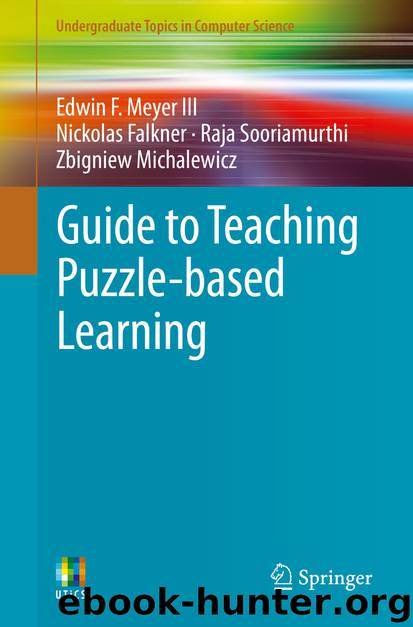Guide to Teaching Puzzle-based Learning by Edwin F. Meyer Nickolas Falkner Raja Sooriamurthi & Zbigniew Michalewicz

Author:Edwin F. Meyer, Nickolas Falkner, Raja Sooriamurthi & Zbigniew Michalewicz
Language: eng
Format: epub
Publisher: Springer London, London
(b)Area, where x > y (light part), when the boy is on time
As any point within the rectangle can occur with equal likelihood, it is sufficient to find the ratio between the dark area of the rectangle and the area of the whole rectangle to calculate the probability of the boy being late. This is easy:The dark area: 3 × 3 / 2 = 4.5
The whole rectangle: 4 × 6 = 24
Thus, the probability of the boy being late is exactly
So our earlier estimations, where we used simpler models of the problem, 17 and 18.5 %, were not that bad.
There is also a way for arriving at a solution by simulation. We can generate a large number N of random points A from the intervals 7:58 ≤ x ≤ 8:02 and 7:55 ≤ y ≤ 8:0, with a point A having two coordinates, x and y,
Download
This site does not store any files on its server. We only index and link to content provided by other sites. Please contact the content providers to delete copyright contents if any and email us, we'll remove relevant links or contents immediately.
| Administration | Assessment |
| Educational Psychology | Experimental Methods |
| History | Language Experience Approach |
| Philosophy & Social Aspects | Reform & Policy |
| Research |
The Art of Coaching Workbook by Elena Aguilar(51071)
Trainspotting by Irvine Welsh(21564)
Twilight of the Idols With the Antichrist and Ecce Homo by Friedrich Nietzsche(18564)
Fangirl by Rainbow Rowell(9172)
Periodization Training for Sports by Tudor Bompa(8209)
Change Your Questions, Change Your Life by Marilee Adams(7678)
This Is How You Lose Her by Junot Diaz(6830)
Asking the Right Questions: A Guide to Critical Thinking by M. Neil Browne & Stuart M. Keeley(5705)
Grit by Angela Duckworth(5553)
Red Sparrow by Jason Matthews(5422)
Paper Towns by Green John(5136)
Room 212 by Kate Stewart(5067)
Ken Follett - World without end by Ken Follett(4681)
Housekeeping by Marilynne Robinson(4391)
The Sports Rules Book by Human Kinetics(4339)
Double Down (Diary of a Wimpy Kid Book 11) by Jeff Kinney(4240)
Papillon (English) by Henri Charrière(4223)
The Motorcycle Diaries by Ernesto Che Guevara(4047)
Exercise Technique Manual for Resistance Training by National Strength & Conditioning Association(4016)
